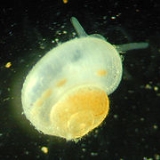
Troglobite
Encyclopedia
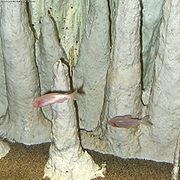
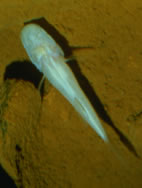
Cave
A cave or cavern is a natural underground space large enough for a human to enter. The term applies to natural cavities some part of which is in total darkness. The word cave also includes smaller spaces like rock shelters, sea caves, and grottos.Speleology is the science of exploration and study...
-dwelling animal
Animal
Animals are a major group of multicellular, eukaryotic organisms of the kingdom Animalia or Metazoa. Their body plan eventually becomes fixed as they develop, although some undergo a process of metamorphosis later on in their life. Most animals are motile, meaning they can move spontaneously and...
s that have adapted
Adaptation
An adaptation in biology is a trait with a current functional role in the life history of an organism that is maintained and evolved by means of natural selection. An adaptation refers to both the current state of being adapted and to the dynamic evolutionary process that leads to the adaptation....
to their dark surroundings. Troglobite species include spider
Spider
Spiders are air-breathing arthropods that have eight legs, and chelicerae with fangs that inject venom. They are the largest order of arachnids and rank seventh in total species diversity among all other groups of organisms...
s, insect
Insect
Insects are a class of living creatures within the arthropods that have a chitinous exoskeleton, a three-part body , three pairs of jointed legs, compound eyes, and two antennae...
s, fish
Fish
Fish are a paraphyletic group of organisms that consist of all gill-bearing aquatic vertebrate animals that lack limbs with digits. Included in this definition are the living hagfish, lampreys, and cartilaginous and bony fish, as well as various extinct related groups...
and others. They live permanently underground and cannot survive outside the cave environment. Troglobite adaptations and characteristics include a heightened sense of hearing, touch and smell. Loss of under-used senses is apparent in the lack of pigmentation as well as eyesight in most troglobites. Troglobite insects also exhibit a lack of wings
Insect wing
Insects are the only group of invertebrates known to have evolved flight. Insects possess some remarkable flight characteristics and abilities, still far superior to attempts by humans to replicate their capabilities. Even our understanding of the aerodynamics of flexible, flapping wings and how...
and longer appendage
Appendage
In invertebrate biology, an appendage is an external body part, or natural prolongation, that protrudes from an organism's body . It is a general term that covers any of the homologous body parts that may extend from a body segment...
s.
Common misconceptions
Troglophiles, trogloxenes and troglobites are often confused with one another. A troglophile is a cave-dwelling animal that may complete its life cycle in a cave, but can also survive in above ground habitats. Troglophiles usually maintain some of their senses such as partial pigmentation and are usually only partially blind. A trogloxene is an animal that uses caves for shelter but does not complete its life cycle in them; for example, bats. A troglobite is different in that it cannot survive outside its cave environment. Troglobites may descend from troglophiles over time, through adaptationAdaptation
An adaptation in biology is a trait with a current functional role in the life history of an organism that is maintained and evolved by means of natural selection. An adaptation refers to both the current state of being adapted and to the dynamic evolutionary process that leads to the adaptation....
. Stygophiles, stygoxenes and stygobites can also be confused. Stygophiles are aquatic troglophiles that are partial to caves; they live in them, but are not restricted to them. Stygoxenes are aquatic trogloxenes. They visit caves but do not complete their life cycle in them. Stygobites are aquatic troglobites that complete their entire life in the cave environment.
Environment
Troglobites usually live in moderate cave regions. The overall climates of these caves do not significantly change throughout the year. Humidity in such caves is generally high ranging from 95 to 100 percent; evaporation rates are low. Terrestrial troglobites are seldom found in tropical caves. Conversely, aquatic troglobites, or stygobites, are more commonly found in caves with tropical and subtropical climates.The cave ecosystem in which troglobites reside can be divided into four zones: entrance, twilight, transition and deep cave. The entrance zone is where the surface and underground environments meet. Light becomes scarcer in the twilight zone. The transition zone is almost completely dark; however some outside environmental effects can still be felt. Finally the deep cave zone is completely dark, relatively stable, and exhibits no evaporation. Troglobites are found in the deep cave zone.
Diet
.jpg)
Zooplankton
Zooplankton are heterotrophic plankton. Plankton are organisms drifting in oceans, seas, and bodies of fresh water. The word "zooplankton" is derived from the Greek zoon , meaning "animal", and , meaning "wanderer" or "drifter"...
)." Food is also found from trogloxene carcasses, egg deposits and feces. Bat guano is another source of food for troglobites. Stygobites feed on plankton, bacteria and plants found in streams.
Troglobites often have very low metabolisms to survive in a low-oxygen environment where food is scarce. Because of their low metabolisms and sedentary lifestyles, troglobites are able to live longer than other species. The crayfish
Crayfish
Crayfish, crawfish, or crawdads – members of the superfamilies Astacoidea and Parastacoidea – are freshwater crustaceans resembling small lobsters, to which they are related...
Orconectes australis of Shelta Cave
Shelta Cave
Shelta Cave is a long underground cave and lake located in Huntsville, Madison County, Alabama. It is described as one of the most biodiverse caves within the Appalachian Mountains. The cave is currently owned and managed as a nature preserve by the National Speleological Society, with their main...
in Alabama illustrates this point, as it may reproduce at 100 years, and live to 175.
Reproduction
Reproduction varies depending on troglobitic species. Reproduction in troglobites is infrequent.Evolution and dispersal
Troglobites have evolved in isolation. Stratigraphic barriers, such as rock walls and layers have prevented the dispersal of these animals; consequently species often consist of just a handful of individuals in one cave, or one room of one cave. FluvialFluvial
Fluvial is used in geography and Earth science to refer to the processes associated with rivers and streams and the deposits and landforms created by them...
barriers, such as rivers and streams prevent terrestrial troglobites from spreading.
Species
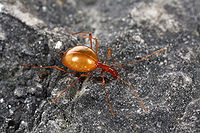
Turbellaria
The Turbellaria are one of the traditional sub-divisions of the phylum Platyhelminthes , and include all the sub-groups that are not exclusively parasitic. There are about 4,500 species, which range from to in length...
ns, gastropods, millipede
Millipede
Millipedes are arthropods that have two pairs of legs per segment . Each segment that has two pairs of legs is a result of two single segments fused together as one...
s, spider
Spider
Spiders are air-breathing arthropods that have eight legs, and chelicerae with fangs that inject venom. They are the largest order of arachnids and rank seventh in total species diversity among all other groups of organisms...
s, pseudoscorpion
Pseudoscorpion
A pseudoscorpion, , is an arachnid belonging to the order Pseudoscorpionida, also known as Pseudoscorpiones or Chelonethida....
s, harvestmen, isopods
Isopoda
Isopods are an order of peracarid crustaceans, including familiar animals such as woodlice and pill bugs. The name Isopoda derives from the Greek roots and...
, amphipods
Amphipoda
Amphipoda is an order of malacostracan crustaceans with no carapace and generally with laterally compressed bodies. The name amphipoda means "different-footed", and refers to the different forms of appendages, unlike isopods, where all the legs are alike. Of the 7,000 species, 5,500 are classified...
, decapods
Decapoda
The decapods or Decapoda are an order of crustaceans within the class Malacostraca, including many familiar groups, such as crayfish, crabs, lobsters, prawns and shrimp. Most decapods are scavengers. It is estimated that the order contains nearly 15,000 species in around 2,700 genera, with...
, collembolans, diplurans, beetle
Beetle
Coleoptera is an order of insects commonly called beetles. The word "coleoptera" is from the Greek , koleos, "sheath"; and , pteron, "wing", thus "sheathed wing". Coleoptera contains more species than any other order, constituting almost 25% of all known life-forms...
s, fish
Fish
Fish are a paraphyletic group of organisms that consist of all gill-bearing aquatic vertebrate animals that lack limbs with digits. Included in this definition are the living hagfish, lampreys, and cartilaginous and bony fish, as well as various extinct related groups...
es and salamander
Salamander
Salamander is a common name of approximately 500 species of amphibians. They are typically characterized by a superficially lizard-like appearance, with their slender bodies, short noses, and long tails. All known fossils and extinct species fall under the order Caudata, while sometimes the extant...
s.
Troglobites can be found worldwide. Turbellarian species can be found in the United States
United States
The United States of America is a federal constitutional republic comprising fifty states and a federal district...
, Europe
Europe
Europe is, by convention, one of the world's seven continents. Comprising the westernmost peninsula of Eurasia, Europe is generally 'divided' from Asia to its east by the watershed divides of the Ural and Caucasus Mountains, the Ural River, the Caspian and Black Seas, and the waterways connecting...
and Japan
Japan
Japan is an island nation in East Asia. Located in the Pacific Ocean, it lies to the east of the Sea of Japan, China, North Korea, South Korea and Russia, stretching from the Sea of Okhotsk in the north to the East China Sea and Taiwan in the south...
. Troglobitic gastropods are endemic to the U.S and in Europe; they are mostly concentrated in the northeastern Mediterranean regions. Stygobite gastropods are found in the U.S, Europe and Japan. Troglobite scorpions are mostly found in Mexican caves. Troglobitic spiders are found more widespread in the U.S., Europe, and Japan. However, they are also found in Mexico, Congo, Cuba and the Philippines. Terrestrial troglobite gastropods are found not only in Europe and the U.S but also in Cuba, Mexico, Burma, Congo and Venezuela. Aquatic troglobite isopods can be found in similar areas and also in Madagascar. Troglobite amphipods found in similar areas as isopods but can also be found in Africa, Australia and Brazil. Troglobite collumbolans are found in the U.S, Europe, Japan, Mexico and Cuba. Troglobite salamanders are found in Europe and the U.S.
Roughly 7,700 species of troglobite are known to date. Approximately 90% of caves worldwide remain undiscovered due to lack of visible entrances. Consequently, many troglobite species that may be living in these caves have yet to be discovered.
Terrestrial troglobites
Carabid beetles of the subfamily Trechinae are the most common type of terrestrial troglobites. These particular troglobitic beetles range from 5 millimetre.In general, troglobite beetles are predators and feed on other troglobites rather than bacteria, twigs and guano. They are often found in wet places, near streams. Troglobite beetles have reduced eyes and wings; however, some species have neither. They are not typically found in tropical caves. Troglobitic millipedes however, are the most common terrestrial troglobite found in tropical caves. Troglobite spiders, like beetles, are not well represented in tropical caves. Terrestrial troglobites are almost completely restricted to the deep cave zone where there is neither light nor evaporation but a stable environment.
Francis G. Howarth hypothesized on other possible terrestrial troglobite adaptations to cave environment, postulating that "terrestrial troglobites have lost many of the water conservation mechanisms of surface relatives, and more nearly resemble permanently aquatic arthropods in water balance mechanisms, including cuticular permeability." Troglobites thrive in a humid environment and when a "chamber is too dry ... animals display either agitated or comatose behavior". This may be part of the reason terrestrial troglobites are not typically found in tropical cave environments. Tropical caves are warmer and consequently have a higher level of evaporation due to higher temperatures.
Aquatic troglobites
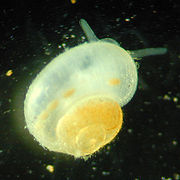
Stygobites generally feed on plants, algae and bacteria. Species include aquatic gastropods, crayfish and fish among others.
Discovery
Cave biology can be dated back to the late 18th century, when one of the first discovered aquatic troglobites, the Proteus Salamander, more commonly referred to as an "olmOlm
The olm, or proteus , is a blind amphibian endemic to the subterranean waters of caves of the Dinaric karst of southern Europe. It lives in the waters that flow underground through this extensive limestone region including waters of the Soča river basin near Trieste in Italy, through to southern...
", was discovered. These blind white salamanders were thought to be baby dragon
Dragon
A dragon is a legendary creature, typically with serpentine or reptilian traits, that feature in the myths of many cultures. There are two distinct cultural traditions of dragons: the European dragon, derived from European folk traditions and ultimately related to Greek and Middle Eastern...
s by the locals of the time. They are the largest troglobites known to date and can measure up to a foot long.
In more recent times, more troglobite species are being identified. In Sequoia
Sequoia National Park
Sequoia National Park is a national park in the southern Sierra Nevada east of Visalia, California, in the United States. It was established on September 25, 1890. The park spans . Encompassing a vertical relief of nearly , the park contains among its natural resources the highest point in the...
and Kings Canyon National Park
Kings Canyon National Park
Kings Canyon National Park is a National Park in the southern Sierra Nevada, east of Fresno, California. The park was established in 1940 and covers...
s, in the Sierra Nevada mountains of California, scientists recently discovered 255 new caves, and 30 undescribed invertebrate species – "an extraordinary number for such a small area".
Threats to troglobites
Floodwaters can be detrimental to troglobite species. Consequently, stygobites can be swept out of the cave. Floods accompany a drop in temperature and a slight raise in pHPH
In chemistry, pH is a measure of the acidity or basicity of an aqueous solution. Pure water is said to be neutral, with a pH close to 7.0 at . Solutions with a pH less than 7 are said to be acidic and solutions with a pH greater than 7 are basic or alkaline...
. Troglobites tend to be temperamental and these conditions are not easily sustainable by them. Extreme winter temperatures are also intolerable. Birds and bats in caves prey on troglobites. Troglobites also compete with each other for survival.
Humans also pose a threat to troglobites. Pesticides and sewage from cities poison troglobite communities. Scientific cave explorations can also harm these creatures.
See also
- Troglophile
- SpeleologySpeleologySpeleology is the scientific study of caves and other karst features, their make-up, structure, physical properties, history, life forms, and the processes by which they form and change over time...
- Cave conservationCave conservationCave conservation is the protection and restoration of caves to prevent or minimise the effects of human activity on caves.Some caves have delicate features that can be disturbed by changes in light levels, humidity and air flow. Caves that have lighting that remains on are prone to having algae...
- List of troglobites
- Subterranean riverSubterranean riverA subterranean river is a river that runs wholly or partly beneath the ground surface – one where the riverbed does not represent the surface of the Earth ....

